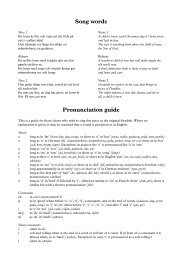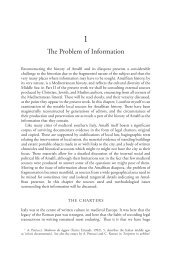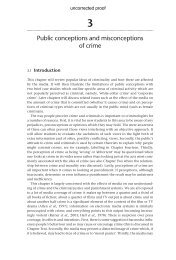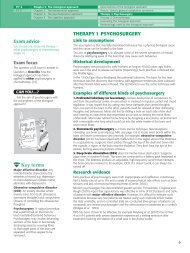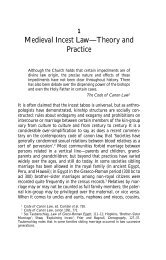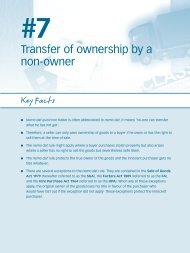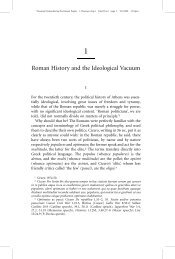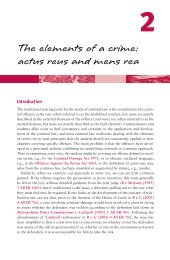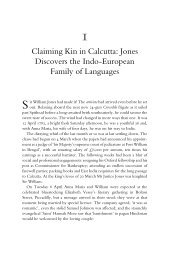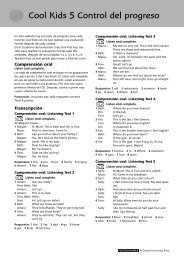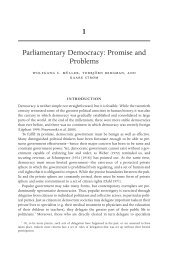Chapter 11 The Tort of Negligence - OED-update - Oxford University ...
Chapter 11 The Tort of Negligence - OED-update - Oxford University ...
Chapter 11 The Tort of Negligence - OED-update - Oxford University ...
Create successful ePaper yourself
Turn your PDF publications into a flip-book with our unique Google optimized e-Paper software.
Rescuers<br />
<strong>Chapter</strong> <strong>11</strong> <strong>The</strong> <strong>Tort</strong> <strong>of</strong> <strong>Negligence</strong> 359<br />
Prior to 1999 it was understood that, in law, rescuers were automatically to be treated as<br />
primary victims and a duty <strong>of</strong> care was owed to a rescuer who suffered mental trauma as<br />
a result <strong>of</strong> helping out in an accident.<br />
Chadwick v British Rail (1967)<br />
Facts: <strong>The</strong> claimant was a volunteer rescuer at the scene <strong>of</strong> a rail disaster where 90 people<br />
died. He later suffered from a psychiatric illness as a result <strong>of</strong> the horrific nature <strong>of</strong> what he had<br />
experienced.<br />
Decision: A duty <strong>of</strong> care was owed to the claimant as it was reasonably foreseeable that<br />
volunteers would assist at the scene and suffer mental illness as a result.<br />
However, in White v Chief Constable South Yorkshire (1999) the House <strong>of</strong> Lords made it clear<br />
that a rescuer could only be classed as a primary victim if the rescuer was, or reasonably<br />
believed himself to be, in danger <strong>of</strong> physical injury. <strong>The</strong> court recognised that Chadwick,<br />
above, was correctly decided because the rescuer in that case was in physical danger from<br />
the collapse <strong>of</strong> the wreckage, but the rescuers in White were not at risk and could not claim<br />
as primary victims.<br />
White v Chief Constable <strong>of</strong> South Yorkshire (1999)<br />
Facts: As a result <strong>of</strong> the negligent failure <strong>of</strong> the police to control admission to the Hillsborough<br />
football stadium in Sheffield, numerous fans were crushed against railings and barricades. Ninetyfive<br />
people were killed and hundreds injured. <strong>The</strong> claimants were police <strong>of</strong>ficers who took part in<br />
the rescue operation and suffered post-traumatic stress disorder (a psychiatric illness) as a result<br />
<strong>of</strong> the horrific scenes they encountered. <strong>The</strong>y sued the Chief Constable <strong>of</strong> Yorkshire Police.<br />
Decision: No duty <strong>of</strong> care was owed by the Chief Constable to the claimants because<br />
the claimants were not actually at risk themselves. <strong>The</strong>y had not been exposed to danger or fear<br />
<strong>of</strong> danger.<br />
Secondary victims<br />
A secondary victim is a person who suffers a psychiatric illness as a result <strong>of</strong> witnessing an<br />
accident or its ‘immediate aftermath’. <strong>The</strong> person himself is in no danger but suffers shock<br />
as a result <strong>of</strong> either seeing another person injured, reasonably believing that another person<br />
is injured, or coming to the scene immediately afterwards. In addition, the secondary<br />
victim must have a close tie <strong>of</strong> love and affection for the victim <strong>of</strong> the accident.




